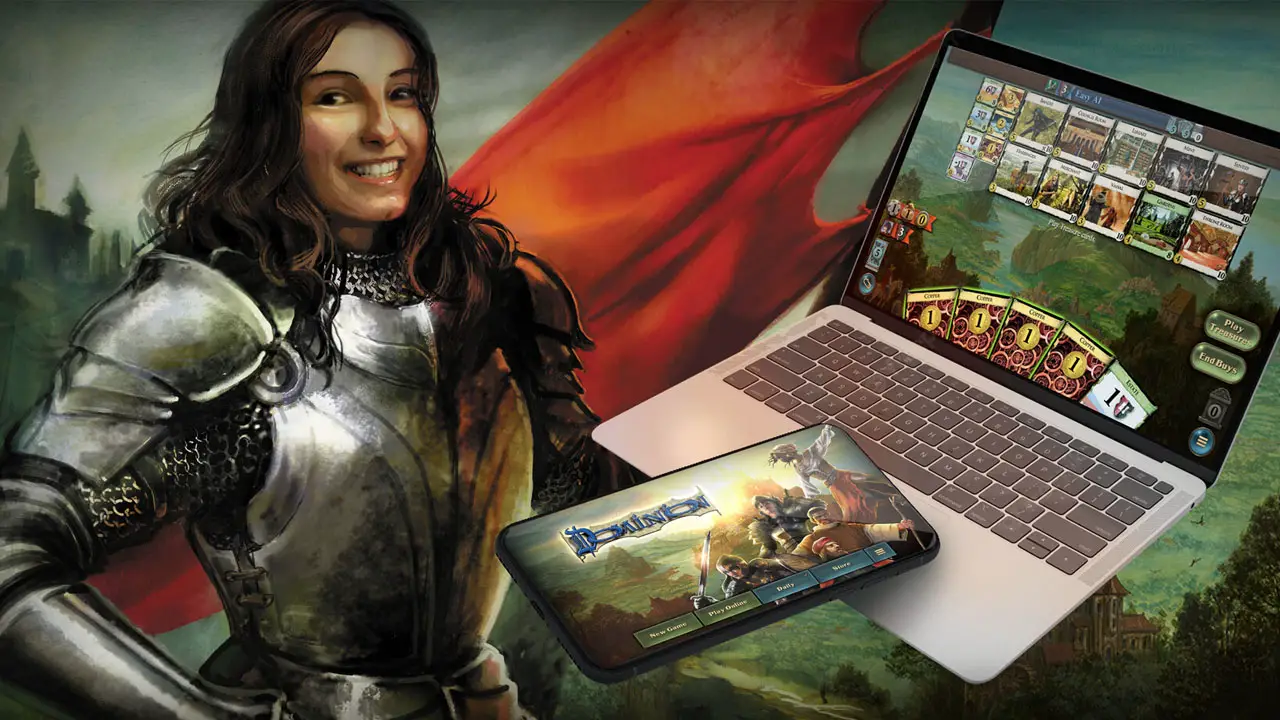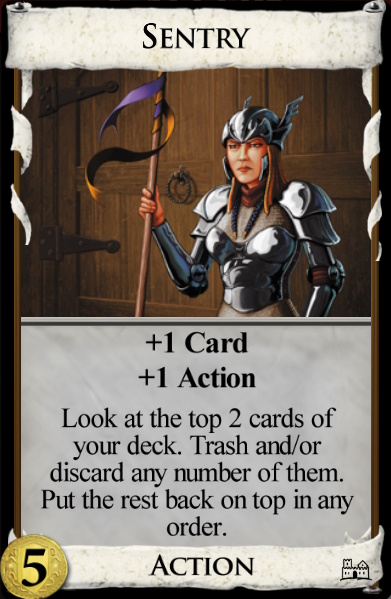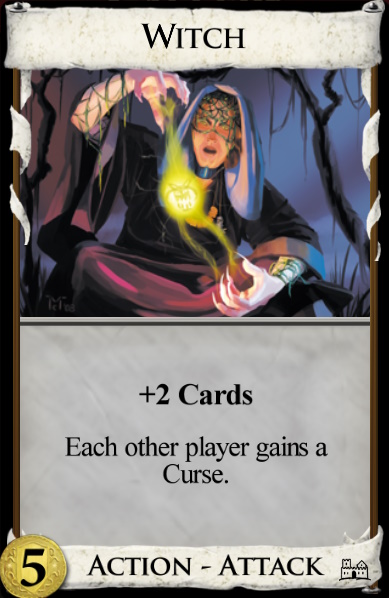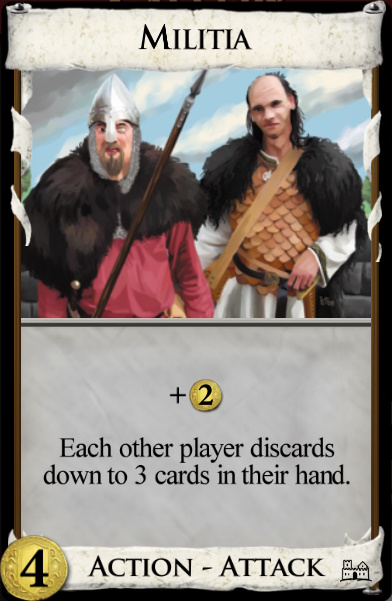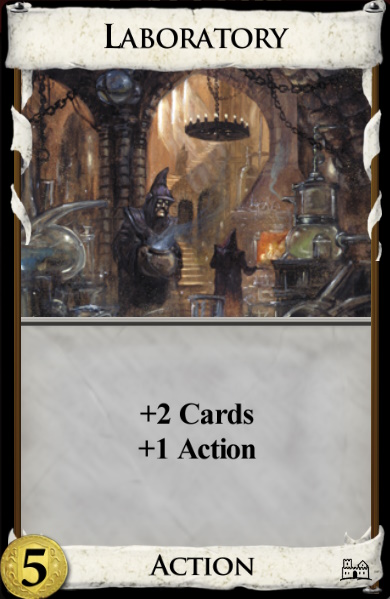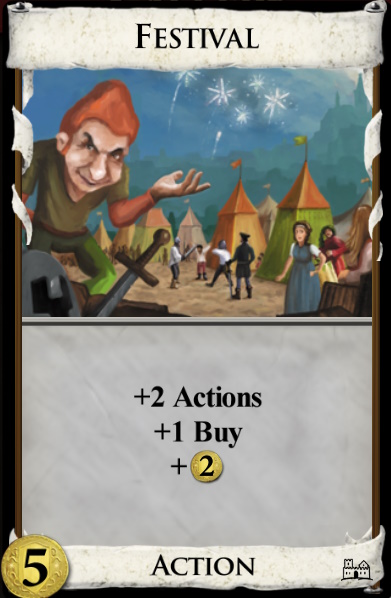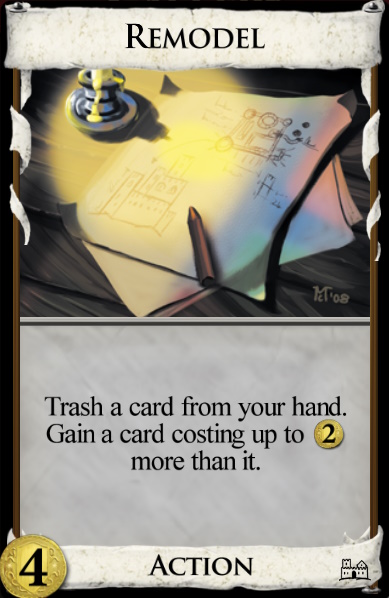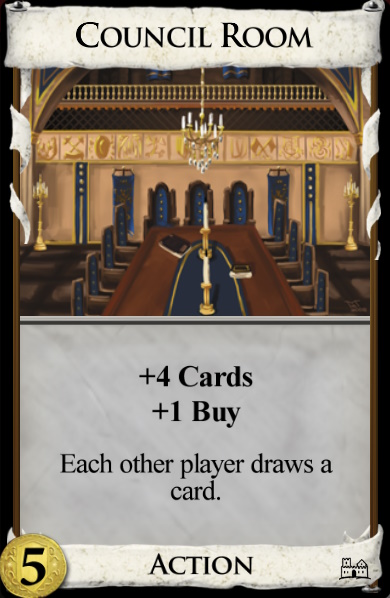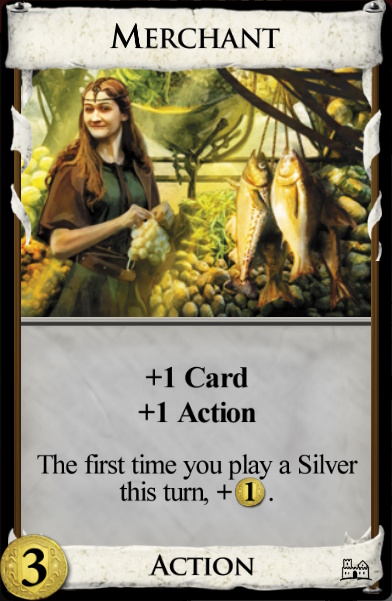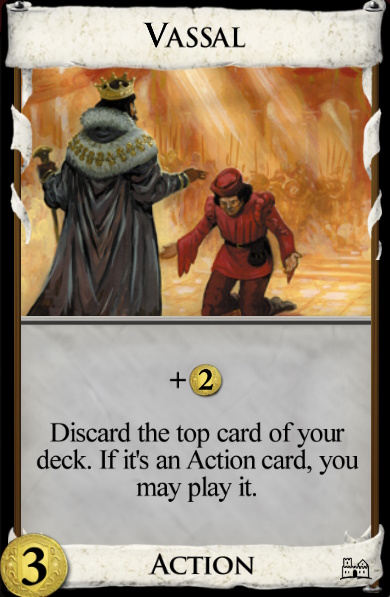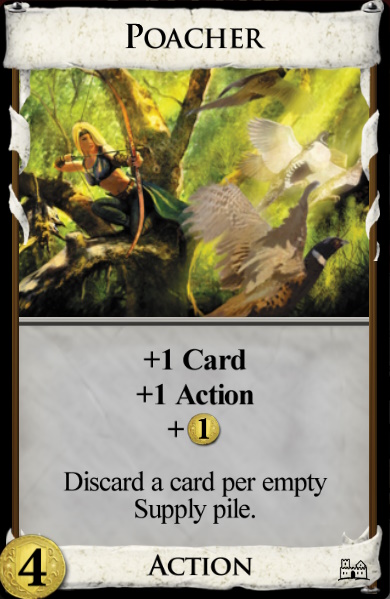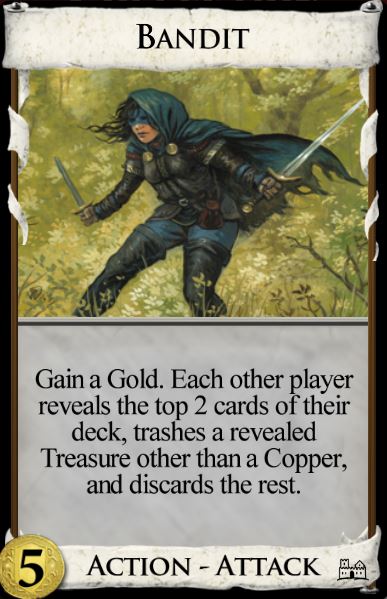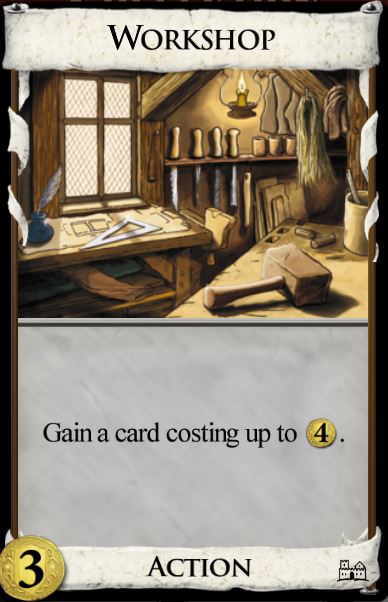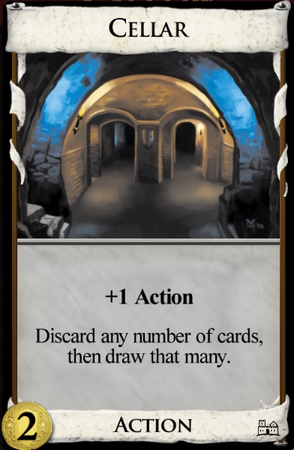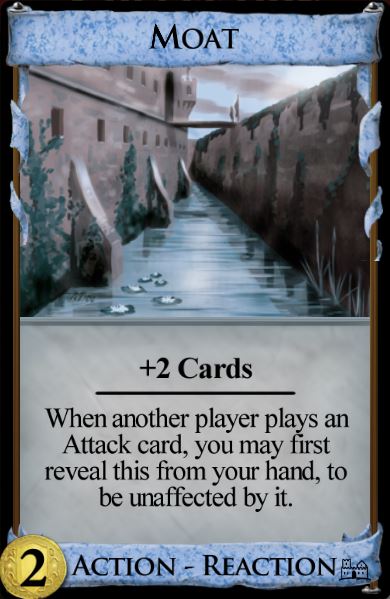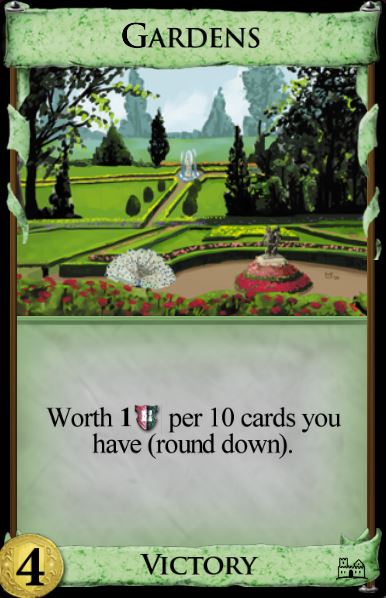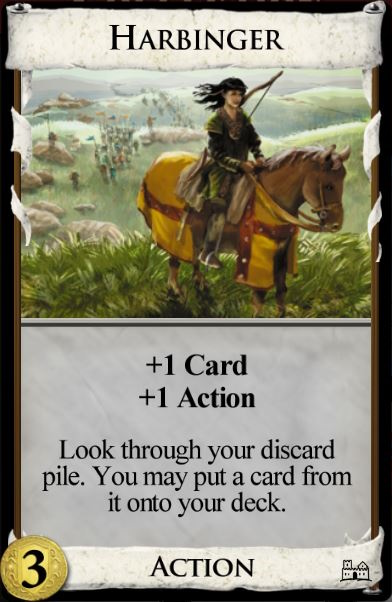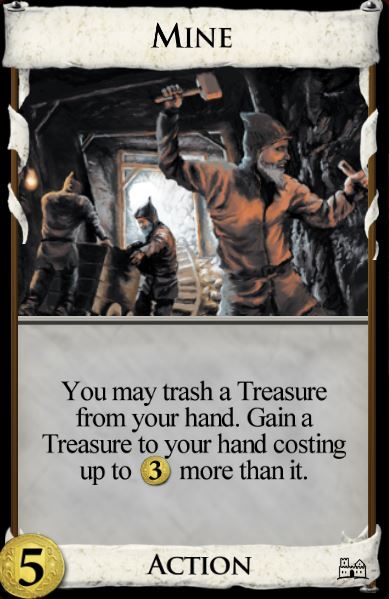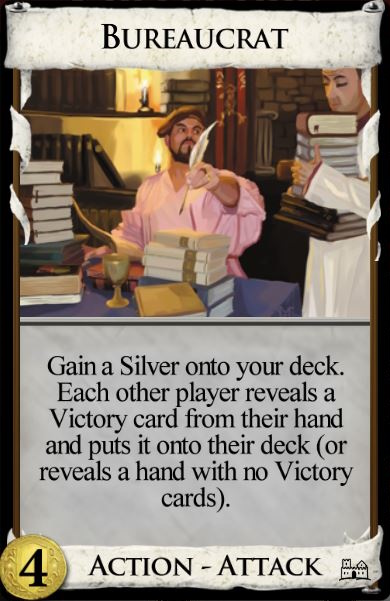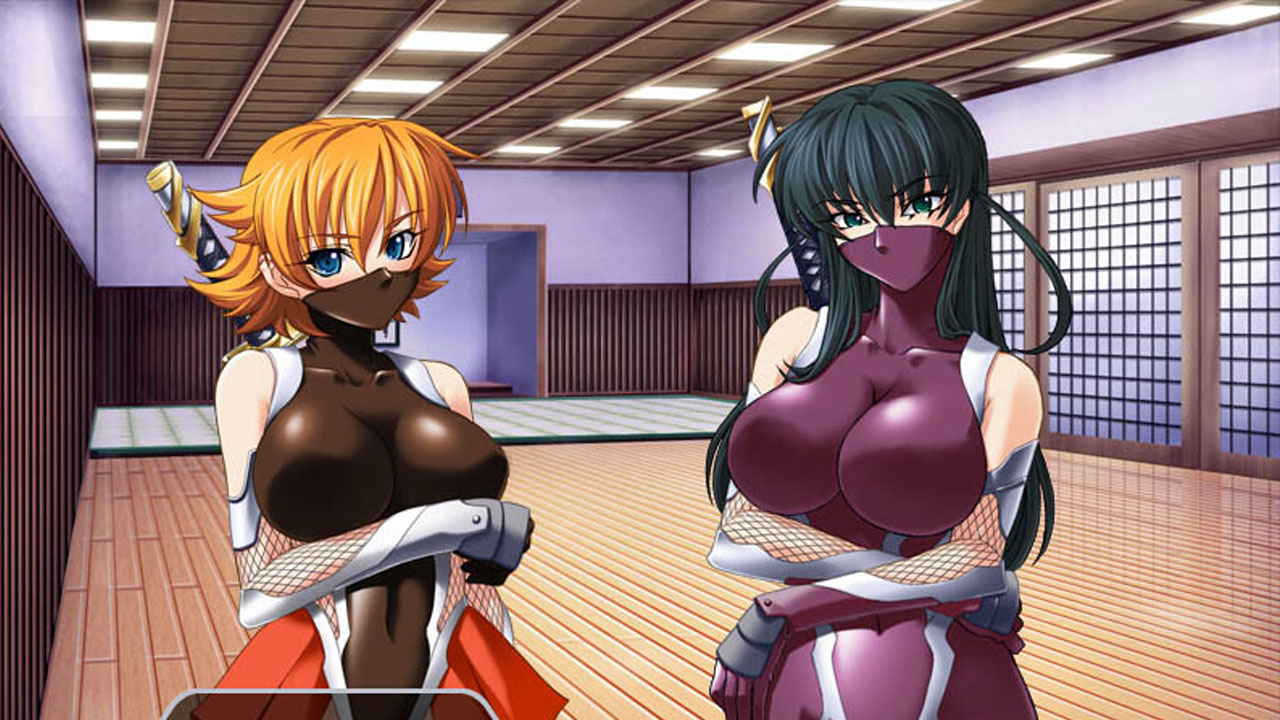What are the best and worst Kingdom cards in the base game?
Méthodologie
This guide arranges the Kingdom cards in the base game from best to worst. Kingdom cards are those that constitute the random selection of 10 pieux, excluding the 7 basic cards (such as Copper, Curse, Province, etc.). The base game comprises 26 Kingdom cards.
The order was determined not by me but by community consensus on the Dominion Discord in 2022 through the annual ThunderDominion ranking process. These rankings primarily focus on 2-player games. Cependant, games with more players can alter the value of certain cards in ways that may not be reflected here.
What does it signify for a Kingdom card to be “mieux” than another? The ThunderDominion rankings intentionally do not provide an answer to this question, leaving it up to the voter to decide.
The ranking consensus on the base game has remained relatively stable for a long time, although some cards may shift up or down a position or two each year, particularly within the middle of the group.
These rankings do not take into account the cards exclusive to the first edition.
#1: Chapelle
There’s no question that Chapel stands out as the most potent kingdom card in the base game, and it’s not even a close competition. Trashing holds significant power, and few cards can match Chapel in this aspect. The astonishing speed at which Chapel can eliminate your starting deck has a profoundly transformative effect on the game.
Its remarkably low cost makes it accessible to all players regardless of their initial shuffle, and it’s challenging to find a compelling reason not to purchase it on turn 1 ou 2 in base-only games. It takes expansions to begin identifying reasons to forgo a Chapel purchase at the start.
The apparent overpowered nature of Chapel might appear as an oversight, but it’s deliberate. Its purpose is to dramatically alter the game when it enters play, aligning with Dominion’s objective of introducing variety in deck-building gameplay. And in that respect, Chapel undeniably accomplishes its intended goal.
#2: Sentry
Chapel has taught us the strength of quickly trashing cards, and Sentry emerges as the second most powerful trasher in the base game, capable of trashing multiple cards at once. Unlike Chapel, which trashes from hand, Sentry operates by trashing cards from the top of your deck while providing +1 Carte et +1 Action. This unique mechanism ensures that Sentry doesn’t diminish the number of cards in your hand on the turn you trash, allowing you to maintain powerful turns while still trashing cards.
As the game progresses and your deck expands with more cards, the density of undesirable cards decreases. Par conséquent, acquiring Sentry becomes a high priority to capitalize on the opportunity to trash undesirable cards while their prevalence is still significant.
Even after the need for trashing diminishes, Sentry remains valuable throughout the game by assisting in discarding unwanted cards, such as Victory cards, and enhancing reliability by rearranging the cards in your deck. It has a particularly noteworthy synergy in the base game with Vassal, mitigating much of the risk associated with playing Vassal.
#3: Witch
Inflicting Curses upon your opponent ranks among the most potent types of attacks in Dominion. Curses are highly undesirable, not only because they deduct points at the game’s conclusion but primarily because they obstruct drawing your advantageous cards.
A strategic approach to receiving fewer Curses from your opponent involves initially transferring all the Curses to them, as Cursing attacks cease once the Curse pile is depleted. This often elevates Cursing attacks to a high priority, and Witch is a prime example.
Witch stands out as a notably formidable Cursing attack since it also facilitates card drawing. Drawing during Cursing attacks holds significant power because it accelerates cycling through your deck, leading to shuffling the Witch back into your deck sooner for subsequent use. This strategy aids in inundating your opponent with Curses as swiftly as possible, granting them fewer opportunities to prepare, react, and retaliate in kind.
Once the Curse supply is exhausted, Witch essentially transforms into a costly version of Moat, which is less efficient for deck drawing compared to cards like Smithy. Cependant, the remarkable benefits it provides in the early game more than compensate for this drawback.
#4: Throne Room
In Dominion, your deck necessitates different effects at various times, both within your turns and on a broader game-wide scale. Par exemple, you might prioritize trashing and Cursing during the early game but not in the late game. Entre-temps, during your turns, you aim to draw more cards initially before unleashing the “payload” towards the turn’s end.
Throne Room offers significant flexibility by enabling you to obtain more of the desired effects precisely when you need them. It allows you to transition your deck from one function to another without needing to acquire specific cards for the shift. Par exemple, you can use Throne Room to duplicate your Witches during the early turns, and then when the Curse pile depletes, redirect those same Throne Rooms to your Artisans on subsequent turns. This spares you from expending gains and buys on additional copies of these cards to alter your deck’s focus.
Another instance: during your turns, you can use Throne Room on your Laboratories to enhance the reliability of drawing your deck, and once everything is drawn, any remaining Throne Rooms can be utilized on your Festivals for increased money. There’s a potential reliability advantage here, as the order in which you draw your Throne Rooms doesn’t matter; they all serve the appropriate function at the right time. Cependant, it’s crucial to note that drawing the Throne Room alongside the correct card is essential. Neglecting additional copies of your draw cards can worsen your reliability when adding more Throne Rooms, as a hand consisting solely of Throne Rooms renders it unable to perform any action.
Throne Room provides you with two additional plays of another card at no extra Action cost, making it akin to a “village.” Playing Throne Room on a card that grants at least +1 Action results in a surplus of +Actions, similar to playing a Village.
Dernièrement, Throne Room stands out as a notably potent version of its kind compared to similar cards from other expansions, chiefly due to its lower cost. Priced at only 4 pièces de monnaie, it’s notably cheaper than its counterparts, most of which cost 5. Throne Room can be acquired through cards like Workshop and can be regarded as a discounted alternative to purchasing an extra copy of the 5-cost card you might use your Throne Room on.
En résumé, Throne Room delivers substantial value at a modest price.
#5: Militia
Militia stands out as a potent attack that inflicts significant disruption on your opponent throughout the entire game. Notamment, its low cost allows for an early opening, which can greatly impede your opponent’s ability to acquire high-priority 5-cost cards and diminish the effectiveness of trashing with Chapel.
Militia effectively dismantles traditional treasure-heavy strategies, compelling your opponent to develop a draw engine if feasible. When stuck with 3-card hands, it becomes exceedingly challenging to amass the necessary 6 coins for a Gold or 8 coins for a Province, leaving such decks trapped in a cycle of repeatedly purchasing Silver and making minimal progress.
Since Militia compels your opponent to discard down to 3 cartes, you only need to play it once per turn, making it a manageable addition to a functional deck for a substantial impact. It particularly shines when your opponent’s hand exceeds 5 cartes, such as after playing Council Room.
#6: Artisan
There are numerous cards across all expansions that can gain cards costing up to 4 pièces de monnaie, known as Workshop variants. Cependant, it’s considerably rarer to find cards capable of gaining 5-cost cards. Artisan stands out as one of these cards, and it possesses the unique ability to gain the card directly into your hand, eliminating the need to shuffle your discard pile first.
Despite the requirement to topdeck a card from your hand, which reduces the number of cards in your hand when you play Artisan, this feature can actually be advantageous in several ways. Par exemple, if you lack remaining Actions to play the newly gained Action card, you can topdeck it for the next turn instead. Other examples include setting up guaranteed Vassal successes or placing a Moat on top of your deck to ensure its presence in your starting hand next turn.
Another significant advantage of Artisan is its ability to gain Duchies, enabling a strong deck to more easily close the points gap later in the game, affording the Artisan player additional time to build a stronger deck.
Given the potency of many 5-cost cards, the ability to gain them directly without purchasing them is indeed powerful, hence Artisan’s strength. Its high cost of 6 coins can pose a challenge to acquire early on. Cependant, by placing the newly gained card either in your hand or on top of your deck, Artisan does not impede your progress when you opt to purchase it instead of another high-priority 5-cost card. You’ll still have the opportunity to play that 5-cost card during the next shuffle when gained via Artisan. Par conséquent, Artisan typically emerges as a top priority card; the primary consideration is how to afford it early in the game.
#7: Laboratoire
When you play a Laboratory, the number of cards in your hand increases by 1. It accomplishes this without requiring investments in villages, as Laboratory refunds its Action cost. Laboratory is straightforward draw, and drawing cards is inherently potent.
A straightforward card with a simple effect that integrates well into almost any deck type. Its reliability is notable due to the absence of ordering concerns associated with villages, making it dependable. Cependant, its reliability comes at a cost. Priced at 5 pièces de monnaie, Laboratory is relatively expensive, so it’s not always prudent to repeatedly purchase Laboratory without consideration.
#8: Village
Village holds such importance in the core identity of Dominion deck-building that we refer to the entire category of cards granting +2 Actions as “villages.”
Action cards lacking at least +1 Action are termed “bornes” because they terminate your Action chain. Villages are essential for playing more than one terminal per turn. Without readily available villages, your options with terminal Action cards become severely limited, significantly altering the game dynamics.
Village serves as an excellent example of a village card. It boasts affordability, and by drawing an additional card, it facilitates the discovery of two other terminal Action cards, allowing you to capitalize on Village’s effect. It’s important to note that this additional card simply replaces the Village in your hand and is not considered true “dessiner” like Laboratory. Par conséquent, incorporating numerous Villages into your deck won’t impact its overall quality. Cependant, if you fail to utilize the extra +Actions, you’re essentially not taking any meaningful actions.
Since villages are unnecessary until you’re likely to draw two terminal cards together, Village is often not a card you’ll prioritize at the start of the game. Néanmoins, its eventual impact on the game cannot be overstated.
#9: Festival
Festival presents a comprehensive set of bonuses within a single card, but notably lacks any +Cards. As a non-drawing village, Festival necessitates a slightly heavier investment in draw to fully leverage its benefits. Cependant, it offers both extra Actions and economy, making it worthwhile if you can manage its additional draw requirements. Festival is an excellent means to ensure you have potent, high-economy turns.
Exercise caution when investing heavily in Festivals, as you pay a premium for the combination of three different bonuses. It’s easy to overlook the Actions or the Buy, resulting in effectively paying 5 coins for a Silver, which is highly inefficient. En outre, accumulating too many Festivals can lead to stalling out your turn.
Festival is particularly noteworthy for serving as an excellent enabler for “draw-to-X” cards like Library, providing numerous bonuses while reducing your hand size.
#10: Remodel
Remodel essentially substitutes cards in your deck for superior ones. The cost of the card you can acquire correlates with the cost of the trashed card, rendering Remodel less effective at removing 0-cost trash like Curses and Coppers. Cependant, it excels at replacing Estates, which are a high priority for removal from your starting deck. Priced at 4, you can open with Remodel for these purposes, albeit at the significant expense of being unlikely to purchase a 5-cost card anytime soon.
Other notable targets for Remodel include other trashers once you’ve streamlined your deck, junking attacks once the Curse supply diminishes, and cards gained by gainers with cost restrictions like Workshop. Silver and Gold are particularly attractive targets, as numerous cards facilitate gaining them in large quantities effortlessly, and they transition into desirable 5-cost cards and Provinces, respectivement.
Remodel also grants a leading player excellent end-game control by “milling” provinces—trashing a Province in hand to acquire another Province—just to deplete the pile and hasten the conclusion of the game.
#11: Marché
Market serves as a versatile source of money that suits any deck, but its most notable feature is its effortless provision of +Buy. It doesn’t require additional Actions or card draw to expand your deck’s purchasing capabilities and also provides an additional coin to enhance the utility of each Buy.
Cependant, as a source of money, Market comes at a relatively high cost, particularly considering that the base game includes Merchant and Poacher, which fulfill this role at a lower price, albeit with additional restrictions. Par conséquent, repeatedly purchasing Market is an inefficient method of increasing your deck’s economic output.
In instances where the base game lacks robust payload options for your deck, Market can emerge as the best choice despite its inefficiencies. Beyond the base game, certain expansions introduce powerful inexpensive cards that complement Market exceptionally well, or feature cost reduction mechanisms that amplify Market’s capacity as a reliable source of Buys.
When utilizing Markets primarily for money, the surplus Buys can offer strategic control over ending the game by rapidly purchasing out inexpensive piles, such as Estates. Par conséquent, even though excess Buys may sometimes appear redundant, it’s important not to underestimate their potential impact.
#12: Moneylender
Moneylender effectively trashes the undesirable Coppers from your deck while providing you with a substantial amount of coins to spend immediately, enabling you to acquire powerful cards while simultaneously slimming down your deck. This dual function of trashing and providing coins distinguishes Moneylender from many other trashers, which often struggle to achieve both simultaneously.
Alors que 3 coins may seem significant, it’s important to recognize that you don’t get to utilize the Copper you’ve trashed. Par conséquent, the coins-per-card ratio you receive from Moneylender is no better than simply adding a Silver to your deck. Ainsi, Moneylender essentially functions as a Silver that costs an Action but removes a Copper, which is a favorable exchange.
Cependant, Moneylender is notably slower compared to Chapel and is often disregarded in the presence of Chapel. En outre, Moneylender cannot trash Estates, which are typically a more pressing target for removal early in the game.
#13: Council Room
Council Room excels at drawing a substantial number of cards and then granting you a +Buy to maximize the utility of those drawn cards. Drawing 4 cards surpasses the draw capabilities of most similar cards, reducing the need to add additional draw to your deck. Cependant, the significant downside is that all of your opponents also gain an extra card.
The impact of this extra card on your opponent can vary depending on the type of deck they are constructing and the number of Council Rooms you play, as the extra card draw accumulates. If you play too many Council Rooms every turn, it becomes relatively easy for your opponent to swiftly purchase Provinces with a simple treasure strategy, especially if they incorporate their own Council Room for additional Buys and lucrative turns. inversement, if your opponent is also building a potent drawing action engine with Council Rooms, you may inadvertently aid each other, minimizing the disadvantage.
Council Room synergizes well with supplementary draw cards like Laboratory, which helps alleviate the need to play too many Council Rooms each turn. When Militia is present in the kingdom, it enables you to discard all the extra cards from your opponent’s hand, effectively mitigating the drawbacks of Council Room and rendering it very potent.
#14: Forge
Smithy is the most straightforward Action card in the game. It simply draws you cards, but requires village support to be fully effective. Drawing cards is inherently beneficial, so Smithy remains relevant in many game scenarios.
One notable aspect of Smithy is its affordability compared to similar cards, but it lacks additional bonuses that its counterparts offer. This low cost makes it easily obtainable through Workshop variants, often allowing players to add numerous Smithies to their deck effortlessly. Par ailleurs, its inexpensive price enables players to open with Smithy and Silver, providing the opportunity to acquire expensive cards early, such as Artisan.
Smithy’s archetype of “terminal draw” is essential to Dominion, akin to Village. While Smithy is the most iconic card in this archetype, it doesn’t particularly stand out among its peers. Despite its simplicity, Smithy remains a fundamental component of many Dominion strategies.
#15: Marchand
The Merchant is a very cheap and flexible source of coins, provided you can draw a Silver on the same turn. If you fail to draw a Silver, the Merchant effectively does nothing, merely replacing itself for no benefit, the same as if you had just not bought it in the first place.
If you are not planning to draw your entire deck on most turns, the Merchant comes with an inherent risk, but it allows the decks that do heavily invest in trashing and drawing a cheap way to build up economy to make the investment worthwhile. It does not require further supporting draw to be added, in contrast to Silver at the same price.
Watch out for treasure-trashing attacks like Bandit! If you lose your last Silver and are heavily invested in Merchants, your entire economy can collapse in an instant. So you will need some redundancy, or possibly it will simply not be worth the risk.
#16: Vassal
Vassal is a high-risk, high-reward strategy. It can be a very affordable way of adding coins to a deck, but only if it successfully finds an Action card in the deck that you want to play next. When Vassal finds an action and you choose to play it, it’s like Vassal providing an extra +1 Action and +1 Carte.
When it doesn’t find an Action card you want to play, it’s worse than Silver because it costs an Action. This also happens when you have no cards left in your deck or discard, so you can’t wait until you’ve finished drawing your deck first. You have to play it in the middle of drawing your deck, when suddenly losing an Action can be catastrophic, ending your turn early.
Vassal requires you to build your deck in a certain way to make it worth it. You want to have a high density of Action cards, so being able to trash your starting cards is important. Idéalement, you have a lot of Action cards that have at least +1 Action so you don’t accidentally spend your Actions too early. It helps to have spare villages to manage the occasional miss from your Vassals or if you draw them at the end of your deck. Pour terminer, you can guarantee hitting the right card with cards that let you topdeck, like Artisan, or look at the top of your deck, like Sentry.
Généralement, you will be forced to add Victory cards to your deck so Vassal will always confer some risk. But if you achieve the conditions to make it good, you can build a very powerful deck with a high coin output at an incredible bargain.
#17: Poacher
Four coins are a fair price for +1 Carte, +1 Action, et +1 Coin with no conditions, which is what Poacher starts out as. Au fil du temps, it might start making you discard cards as piles empty. Discarding a single card is still a perfectly fine card, but discarding 2 or more is very bad.
It is very risky to obtain lots of Poachers, as your opponents can empty a pile and it will suddenly make your deck significantly worse. This means its presence does not let you lean hard on an action-heavy deck for your economy in the way the other similar cards in the base game do: Marché, Marchand, and Vassal. It is still perfectly fine to buy one or two Poachers in many cases, as a small supplement to some other way of earning economy.
While the discarding is usually a drawback, there are times when it is a positive and you buy Poacher specifically for the discarding. In some expansions, cards benefit explicitly from being discarded. In the base game, Library and Sentry can benefit from it, in the case of Sentry, it is to get junk cards out of your hand so they can be trashed.
The biggest issue Poacher faces is tough competition at its cost in the opening. Poacher is stronger early, but cards like Moneylender or Militia will likely be higher priority, and so you may simply not get around to buying a Poacher in time.
#18: Bandit
Bandit can be primarily considered a Gold gainer. It possesses an attack that attempts to trash other players’ non-Copper treasures, but since it only examines two cards, its search space is limited, resulting in frequent misses unless played in large quantities. This likelihood increases with more players, as multiple opponents may employ Bandits, causing the attack to noticeably impact the game.
Gold is a rather poor card to purchase, as it is quite expensive for its benefits. Acquiring Gold without paying for it is significantly more advantageous. If you have ample draw power to consistently draw many Golds, Bandit can serve as a highly efficient method to boost your economy over multiple turns.
Bandit doesn’t directly enhance your economy until the subsequent shuffle, as you must draw back to the Gold to reap some benefits. In decks with low draw, Bandit might be too slow, as it diminishes your economic output for the current turn and takes time to cycle through your deck until you reshuffle and draw the added Gold. Bandit proves notably more effective in deck-drawing engines, and often, one is sufficient.
Another significant advantage of acquiring Golds is their high coin value, making them ideal for Remodel. The pairing of Bandit and Remodel is arguably the strongest rationale for constructing a deck-drawing engine in the base game, as you can directly Remodel the Golds into Provinces.
#19: Atelier
Workshop can be an effective way to gain many copies of inexpensive cards, provided there are such cards available in the kingdom that you desire multiple copies of. Good targets include Village, Marchand, Throne Room, Jardins, Forge, etc. Its effectiveness relies entirely on the availability of suitable targets in the kingdom. While Silver and Estate are always present, they are typically not the reason for acquiring a Workshop.
An important consideration regarding when to gain a Workshop is the priority of cards costing 5. Some 5-cost cards, such as Sentry or Witch, can be crucial to acquire as early as possible. If you acquire a Workshop within your first two turns, it will directly impede your ability to purchase a 5-cost card during the next shuffle, potentially slowing down your deck significantly. Prioritize establishing control over your deck first, and then incorporate Workshop to accelerate your deck’s development.
An often overlooked advantage of gaining cards during your action phase instead of purchasing them is that you have the opportunity to draw and play the acquired card on the same turn. This enables cards like Workshop to rapidly accumulate more copies of themselves once your deck is functioning smoothly, thereby significantly increasing the number of cards you can gain each turn and improving your turns at a rapid pace.
While Workshop is ranked low according to this methodology, it should be noted that the methodology evaluates these cards within the broader context of Dominion. There are numerous Workshop variants across the expansions, and Workshop tends to be one of the weaker cards in this specific category, often being overshadowed if it appears alongside its counterparts. Cependant, in the context of base-only games, it performs quite well despite this. In base-only games, where the primary theme is cheaper, straightforward versions of standard card effects, Workshop’s core effect becomes more valuable than usual. This is because many good cards in the 4-cost range are available, making Workshop’s ability more advantageous in base-only games.
#20: Cave
At first glance, Cellar might seem like it allows you to draw many cards, assuming you also discard many, thus being an effective way to cycle through your deck to your most powerful cards. What is often missed, toutefois, is that each use of Cellar decreases the number of cards left in your hand by 1, so each time you play one, you are potentially reducing the final output of your turn. It is frequently over-gained by newer players.
Cette “sifting” effect is usually worse than trashing all of your bad cards. If you have already trashed all of your bad cards, what are you going to discard with Cellar? En pratique, decks often end up with some sort of dud card in them eventually, most notably Provinces, and sometimes you draw cards in the wrong order. Généralement, you want to draw your engine pieces first and your “payload” dernier. Cellar can help mitigate bad luck in this regard, provided you have enough draw to draw back the discarded cards.
Cellar is very cheap, which means it is often picked up when an opportunity just so happens to arise and can provide a little bit of extra reliability. It gets better the more cards you have in your hand, as you can sift past more cards at once, so it really wants to be a part of strong engines.
Dernièrement, it has some extra utility when using Library as your primary draw, where the hand-size reduction is no problem and you benefit substantially from removing treasures and victory cards from your hand.
#21: Moat
When used as an action, Moat increases your hand size by 1, which is half the increase provided by Smithy. Costing only 2 pièces de monnaie, this might seem like a reasonable tradeoff; toutefois, it requires a significant amount of additional village support to use Moat as your primary source of draw, which is a kind of hidden extra cost. Draw is still useful and you simply make do with what is offered, but as a source of draw, Moat compares poorly to its peers, particularly having a lot of competition in the base game, which is filled with good draw cards.
It’s worth noting that Festival is a poor village for Moat, as playing Festival then Moat leaves you back at the same number of cards in hand, so trying to draw other cards in this manner is unreliable.
Moat also provides immunity to all attacks as long as it is in your hand. The big challenge is to have Moat in your hand between turns. Occasionally you can guarantee it with a card like Artisan topdecking it at the end of your turn; Par ailleurs, it is purely down to luck. You can increase the odds by having lots of copies, which is a nice benefit if you’re forced to use it as your main source of draw. Typiquement, players will be relying on other forms of draw, so their Moat density will be low, making Moat fairly poor as a form of defense.
Moat gets better with more players, as there are more opponents playing attacks. This makes you more likely to be attacked on any given turn and also more times per turn. Dans 2 player games, it is very common to ignore Moat entirely and simply deal with the attacks. Having a Moat in your starting hand can make it harder to have your turn work out by virtue of it being an inefficient card to start your turn with.
#22: Jardins
Gardens is a victory card that scales gradually. It scales in a very basic way, correlating with the number of cards you own, making it suitable for a wide range of decks. Cependant, its scaling is slow, which makes it challenging to accumulate a significant number of points. It’s relatively easy to make Gardens worth at least 2 points each, and it’s quite common to see it valued at 3 points each. Scaling beyond this level is much less frequent.
One might easily fall into the trap of believing that Gardens is only valuable if you refrain from trashing your starting cards. En réalité, strong engines tend to synergize much better with Gardens, as they have the capacity to acquire numerous cards per turn, swiftly compensating for the loss of starting cards.
Priced at only 4 pièces de monnaie, Gardens falls within the price range of Workshops, which are particularly advantageous for Gardens decks as they enable the acquisition of many cards. Par conséquent, Gardens serves as an incentive to construct engines by offering a straightforward method to score prior to triggering a 3-pile ending, or a quicker means to catch up to opponents gaining Provinces. Cependant, it’s important to note that these robust engine decks typically outperform treasure-heavy decks that slowly acquire Provinces. Alors, while Gardens may hold some allure in these scenarios, it doesn’t always significantly impact the final outcome. If both players are constructing strong engines with ample gains, the game is likely to risk ending with 3 piles before Gardens has the chance to expand substantially.
Finalement, Gardens must always be taken into consideration, but its sluggish scaling often relegates it to little more than a slightly cheaper Duchy.
#23: Bibliothèque
Library is classified as a “draw-to-X” carte, meaning it draws until you have 7 cards in hand. Among draw-to-X cards, this number is relatively high. Starting with a 5-card hand, it draws 3 cartes, similar to Smithy.
The drawback of draw-to-X cards is their inability to stack. Multiple plays of Smithy keep drawing cards, whereas successive plays of Library achieve little without first reducing the number of cards in your hand. This necessitates a deck composition focused on achieving this; Par ailleurs, there’s a soft limit on the effectiveness of your turns.
Typiquement, you seek ways to generate coins from Action cards, such as Festival. These can be played from your hand to decrease hand size before playing another Library to draw back up. Treasures are generally less effective with draw-to-X since you can’t play them until the buy phase. If the action cards require an action, like Militia, then you become heavily reliant on drawing villages early, as drawing them late will result in unplayed action cards remaining in your hand when you need to play your next Library, reducing the number of cards you draw.
Library offers the unique benefit of allowing you to skip past action cards you don’t want to draw immediately. If your deck consists solely of action cards, this enables you to set up a perfect draw of precisely the cards you desire. Cependant, this state usually doesn’t persist, as eventually, you’ll need to purchase Victory cards, and skipping past action cards increases the likelihood of drawing those Victory cards, which may not be desirable. It holds some value in not drawing dead action cards if your turn was unproductive anyway.
Despite its unique effect, Library is costly for what is essentially a subpar type of draw. Its counterparts in other expansions are either much cheaper for a slight reduction in the number of cards drawn or offer significantly better secondary benefits. Especially in the base game, which is replete with draw cards, justifying the inclusion of Library in base-only setups can be challenging. It does have some niche application as a soft counter to Militia if drawn early enough in your turn.
#24: Présage
When you play Harbinger, you draw a card first and then have the option to topdeck a card from your discard pile. This means you need another card if you want to draw the topdecked card on the same turn.
The main issue with Harbinger is that it requires cards in your discard pile for its effect to activate. En outre, you need a card you actually want to topdeck, rather than just Coppers and Estates discarded with Cellar. The most potent decks aim to draw all their cards every turn, resulting in a new shuffle when drawing your starting hand, often leaving you with an empty discard pile.
Adding a Harbinger to your deck doesn’t necessarily harm your deck since the +1 Carte et +1 Action effectively replace the card itself. Cependant, if you’re not topdecking a card, it essentially does nothing, similar to if you had never gained it at all.
Harbinger excels in slow-cycling decks, allowing you to repeatedly retrieve high-value cards like attacks or Gold multiple times within a single shuffle. Même dans ce scénario, if the Harbinger appears too early or too late in the shuffle, you may still end up with no cards in your discard pile.
#25: Exploiter
Mine enhances your treasures by typically upgrading a Copper to a Silver or a Silver to a Gold, though expansions may introduce additional treasures as valid targets. Cependant, most of these treasures cost 4 ou 5 pièces de monnaie, which are not ideal costs for Mine, although it still functions.
In the basic scenario, upgrading one of the basic treasures to the next tier adds 1 coin of economy to your deck. This is akin to using Workshop to gain a Merchant, but Workshop costs much less and can be utilized to acquire other, more potent cards as well. Par ailleurs, Mine unfavorably compares to Bandit, which adds 3 coins of economy to your deck with each play.
The major drawback of Mine lies in its dependency on low-cost treasures. It’s common to trash all your starting Coppers and seek alternative sources of economy, such as action cards, rendering Mine ineffective. Alternativement, you might have a reduced number of treasures, limiting its overall impact. If you’re unable to trash your starting Coppers, Mine offers a means to avoid adding more treasures to your deck, thereby enhancing deck cycling efficiency. Cependant, decks lacking trashing capabilities struggle to cycle quickly enough to frequently play Mine.
Mine does contribute significantly to increasing the value of cards in your deck, particularly useful for Remodel, which upgrades Silvers to Golds for direct transformation into Provinces. Its value also rises when playing with Platinum from the Prosperity expansion, as it provides a 2-coin boost when upgrading Golds to Platinums, compared to the usual 1 pièce de monnaie.
Finalement, Mine ranks among the weakest cards in Dominion. Its effect is gradual and contingent on having treasures, while its 5-coin cost places it in fierce competition with much more potent cards.
#26: Bureaucrat
Silver is not considered a strong card. While it’s sometimes necessary to gain one or two to reach the crucial 5-coin price point, its value beyond that is generally mediocre. Gaining Silver in large quantities is rarely desirable; it doesn’t consistently enable hands worth 8 coins for Provinces and can hinder drawing your other cards.
Bureaucrat, despite being a Silver gainer, often doesn’t align with players’ objectives. Worse yet, it topdecks the Silver, a placement that’s often unfavorable. Not only does it prevent immediate use of the Silver without other means to draw it, but having it in your starting hand next turn can disrupt your engine’s setup. Par exemple, if it displaces a Village from your starting hand, you might end up with an unproductive turn.
While Bureaucrat offers a potential attack that can theoretically be effective, forcing opponents to redraw a useless Victory card, this attack is often impractical. Domaines, typically the highest priority cards for removal from your deck, are usually the only Victory cards present until late in the game. Par conséquent, the attack is ineffective for most of the game. Even when opponents have Victory cards, the attack frequently misses its mark.
Bureaucrat can be seen as an attack card that inflicts more harm on the player using it than on their opponent. It’s widely regarded as one of the weakest cards in Dominion, and easily the weakest in the base game.
